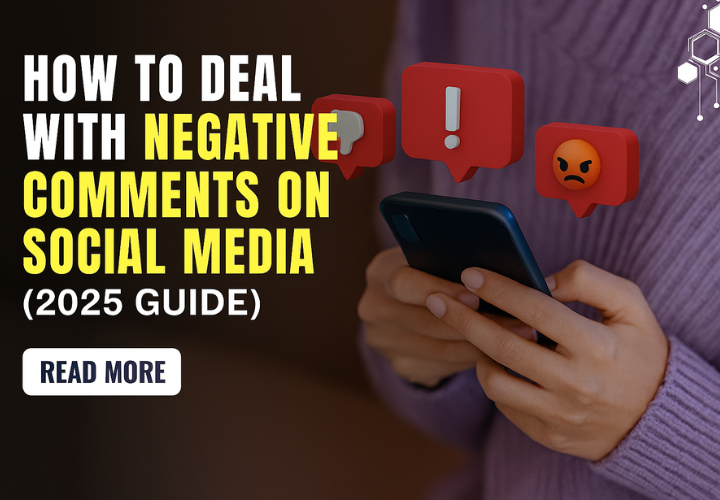Recently updated: September 10th, 2025
In the age of digital marketing social media has emerged as the primary source of engagement for customers. Each brand, regardless of size, company, startup, or large enterprise rely on social media platforms such as Facebook, Instagram, TikTok, YouTube, Twitter (X) and LinkedIn to engage, reach and convert potential customers. However, with sharing, likes and positive reviews comes the inevitable issue of negative reviews.
A single bad post when not properly managed can become viral in minutes. Indeed, research shows that people are more likely to share negative experiences. So, one needs social media marketing services to maintain there brand image.
By 2025, as AI-powered searches and generative engines frequently highlight the reputation of a brand and customer reviews in summary reports and reports, ignoring negative feedback is no longer a viable option. It could directly affect the visibility of your brand, trust, and conversions.
This guide will explain exactly how to deal with negative feedback on social media by 2025. Strategies that are best techniques, case studies, tools and FAQs to ensure that your brand not only withstands criticism, but also turns into a potential.
Why Negative Comments on Social Media Matter
Negative comments aren’t simply random or noise. They are powerful because of:
- Instant Visibility: Due to algorithms that encourage the engagement of users, negative or controversial posts tend to be more popular than positive content.
- Consumer Trust: Based on surveys 88% of consumers trust review sites and feedback in the same way as suggestions from family and friends.
- AI Search Performance: Generative engines like ChatGPT, Perplexity, and Bing Copilot often surface snippets from reviews and discussion. If your company has unresolved problems, AI summaries may highlight these issues.
- Influence on Conversion: searching for a brand typically reads comments prior to making a purchase. Unanswered negatives equal lost leads.
- Reputation Ripple Effect: Negative experiences are shared across forums, platforms and even in media coverage.
The key point to remember is that negative comments can be beneficial. If they are handled properly they show accountability, transparency and customer-first principles.
Types of Negative Comments on Social Media
Understanding the nature of negative remarks can assist in formulating the correct response.
Constructive Criticism
- Example: “The app is great, but the checkout process is slow.”
- The best response is to thank them, acknowledge their contribution, and tell them how you’re getting better.
Emotional Outbursts
- Example: “Worst service ever! I’ll never buy from them again.”
- The best response is to remain in a calm state, apologize, and provide a swift resolution.
Trolling/Spam
- Example: “Your product is trash “
- Best response: Don’t engage. Block, hide or file a complaint after one professional response.
Fake/Competitor-driven Comments
- Examples: fake profiles regularly posting negative reviews.
- The best solution is to collect evidence, submit to the platform, and then respond professionally.
Customer Complaints
- Example: “My order arrived late and customer care didn’t help.”
- The best response is to apologize for the error, send information via DM and offer compensation.
By categorizing comments, you can avoid wasting time with trolls, and instead focus your effort on real customer issues.
Also Read: Advantages and Disadvantages of Social Media For Your Businesses
Golden Rules for Responding to Negative Comments
- Acknowledge Quickly
- Speed equals seriousness. The ability to respond within 2 to 4 hours indicates the commitment.
- Stay Professional and Calm
- Don’t try to match the tone of the customer. A calm, empathetic voice reflects authority.
- Show Empathy
- Expressions such as “We understand how frustrating this must have been” help to reduce the hostility.
- Offer Solutions, Not Excuses
- Customers are looking for resolutions, not blame shifting.
- Take the Conversation Offline
- Provide a DM/email/phone number to resolve issues in private.
- Thank the Customer
- Even negative feedback is valuable insight.
Step-by-Step Framework to Handle Negative Comments (2025 Edition)
Step 1: Monitor using AI-powered Tools
- Tools such as Sprout Social, Hootsuite, Brand24 and Mention today use AI to identify emotions and flag up urgent complaints.
Step 2: Classify the Comment
- Utilize a simple internal procedure: Constructive Emotional / Troll/ Fake or Complaint.
Step 3: Respond Publicly First
- Always make sure to acknowledge your presence in public prior to making a change in private. This will show other users that you are serious about your complaints.
Step 4: Resolve Privately
- Once you have been acknowledged, go to email or DM for more information.
Step 5: Follow Up
- Following resolution, you can politely request the customer to change their review/comment to indicate that they are happy.
Best Practices by Platform
Facebook & Instagram
- Use the comment moderation filter, but be careful not to delete too many comments.
- Post your official response to the hashtag “viral complaint.
- Use stories and reels to resolve frequently asked questions quickly.
Twitter (X)
- Users expect responses within a matter of minutes.
- Do not engage in lengthy debates. Respond quickly and then move on to the DM.
- Maintain a professional tone. Ideal when it comes to brands that are B2B.
- Make use of data-driven solutions and show accountability.
TikTok & Instagram Reels
- Innovative video responses can help humanize your brand.
- Gen Z values humor + authenticity in their responses.
YouTube
- Find an official response under comments on criticism.
- Utilize timestamps in your responses to help viewers find solutions.
Turning Negative Comments Into Opportunities
Negative feedback can actually help strengthen your brand’s reputation if properly handled.
- Transparency Builds Trust – Admitting mistakes in public improves credibility.
- Improved Product/Service – Patterns found in complaints indicate problems to address.
- Customer Loyalty: Customers who get quick, human responses tend to stay for longer.
- Content Creation – Convert FAQs and complaints that are frequently asked for into tutorials, blogs, or even videos.
Example: A food company which was repeatedly receiving complaints about delivery used it as a case-study to improve logistics. The brand then made an online video titled “How We Fixed Our Delivery Times” which received positive publicity.
Common Mistakes to Avoid
- In the absence of comments, silence implies guilt.
- Eliminating Everything Negative – It appears like you’re concealing something.
- Being defensive The customer doesn’t care about excuses.
- Copy-Paste Responses – Feels robotic, worsens reputation.
- Over-Automation Bots responding to angry comments could backfire.
Case Studies (2025 Examples)
Airline Crisis Management
- A UAE airline had to deal with numerous complaints regarding delayed flights. Instead of ignoring the complaints they replied within 30 minutes, provided clear updates, and even offered vouchers. Customers were less angry and a number of posts became positive with praise for transparency.
E-Commerce Startup in Dubai
- The customers complained of defective items. The company apologized publicly and replaced items free of cost, and followed it up through “customer thank-you” posts. A negative buzz turned into loyalty among customers.
Global Tech Brand Example
- When a bug in a product was made to the forefront of Twitter the CEO of the company took it up with his own personal clear apology video and fixing the timeline. The negative hashtags were slowed down in less than 24 hours.
Conclusion
In 2025, coping with negative social media comments isn’t just about managing reputation, it’s an essential strategy for survival of your business. Thanks to AI-driven search, that display customers’ opinions in summaries or overviews, how you handle negative feedback directly impacts the visibility of your business, its conversion rates, and trust.
By being attentive and responding swiftly, remaining professional and utilizing feedback to growth and improvement, companies can turn criticism into trustworthiness. Keep in mind that it’s not about staying away from negative feedback, it’s about how you deal with these comments.
FAQs { Frequently Asked Questions }
Q1. Should I remove negative remarks from social networks?
A: You should only remove spam and abusive trolling. True complaints must be addressed and acknowledged.
Q2. How quickly do I respond to Facebook complaints?
A: Ideally, within 2 to 4 hours on the major platforms. Maximum of 24 hours.
Q3. Do negative feedback affect SEO?
A: Yes. reviews and sentiment impact AI overviews and visibility of brands in the search engine.
Q4. What can I do to deal with Trolls?
A: Don’t argue. Respond once professionally, and then block or hide it.
Q5. What is the role played by AI in dealing with negative feedback?
Answer: AI tools can auto-detect the mood, flag up urgent complaints and even suggest personalised response drafts.




